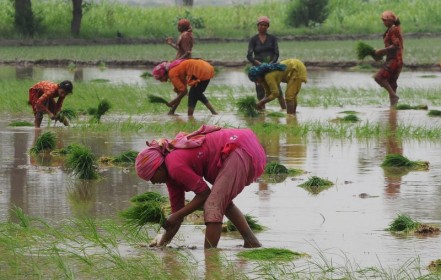Hunger management | Raj Patel
Published on July 6, 2011 at 2:14 PM by FACE OF MALAWI
 Experts predict that there will be ten billion of us by 2100. Feeding the world could be the political challenge of the century.
Experts predict that there will be ten billion of us by 2100. Feeding the world could be the political challenge of the century.
Farmers plant rice in a paddy field in the outskirts of Lahore. Photograph: Getty Images.
How will we eat in the future? By 2100, the world’s population is projected to reach ten billion. The highest levels of consumption will be in Europe and North America, most people will live in Asia and the highest population growth rates in Africa – where the population could triple over the next 90 years. If tomorrow augurs ill, today is already pretty dire. The global recession has lowered incomes, raised food prices and pushed the number of hungry people to one billion.
We’re poorly set to cater for tomorrow. The policies designed to keep prices low have been responsible for greater instability. Countries were meant to be able to ride out bad weather and poor harvests through trade liberalisation. Grain stores were sold off because, in the event of emergency, the market would provide. But it didn’t. Trade and financial networks have instead become excellent conduits for international shocks. Last year, fires in Russian wheat fields led to riots in Mozambican cities. Commodity speculation has made prices more volatile, and climate change has driven up prices too. Poor weather helped drive bread prices higher this year, fanning the flames of the Arab spring and deepening the woes of China’s thousands of protesting migrant workers.
If these are the dividends of the 21st-century food market, then it is unsurprising that the old-fashioned idea that a country might produce a little more of its own food is enjoying rising popularity. There is, however, a war over how to do that. The Oxford economist Paul Collier recently berated the “romantics” who were nostalgic for peasant agriculture. He called for big agriculture, genetically modified crops and for the EU and US to stop domestic subsidies. He is right on the last point: biofuel subsidies drive up food prices, siphoning grain from the poorest into the petrol tanks of the richest. On other points, Collier’s facts seem shakier. In its 2008 World Development Report, the World Bank found that, on the contrary, investment in smallholder agriculture was among the most efficient and effective ways of bringing people out of poverty and hunger. The question is what sort of investment to bring to small farmers.
Share and care alike
Consider Malawi – a battlefield for the future of farming. A landlocked country a little smaller but with a third more people living in it than Greece, it features consistently among the world’s poorest places. The latest figures show nine out of ten people living on the equivalent of less than $2 a day. More than 70 per cent of Malawians live in the rural areas, where nearly every farmer grows maize but not enough people can afford to eat it – about 40 per cent of Malawi is poor and “food-insecure”.
Like elsewhere in Africa, the soil in Malawi isn’t as rich as the rest of the world’s. Farming everywhere depletes the soil of nutrients such as nitrogen, phosphorus and potassium, and poor farmers in Africa in general use very little fertiliser. These missing molecules have led the Bill and Melinda Gates Foundation, supported by various political leaders, to call for a green revolution in Africa directed at small farmers.
This is something of a reversal of Collier’s conventional wisdom, which insists that the best way for Malawi to become food-secure is to have large estates exporting things in which the country has a comparative advantage – mainly tobacco – and buy grain on the international market. Today, large-estate tobacco farming is in decline, which means there is less foreign exchange with which to import food.
Being landlocked, Malawi also faces higher prices for grain. According to one estimate, the marginal cost of importing a tonne of food-aid maize is £250, £125 a tonne to import it commercially and only £30 to source it domestically using fertilisers. At a time when food and fertiliser prices are predicted to rise, Malawi is sensible to consider how vulnerable to the caprices of international markets it wants to be.
This partly explains why, in the late 1990s, the Malawian government decided to spend the greater part of the department of agriculture’s budget on subsidising fertiliser. The president, Bingu wa Mutharika, expanded the programme over 2005-2006, boosting production by between 300,000 and 400,000 tonnes, or up to 15 per cent. The government reports that maize production has remained surplus to national requirements ever since. A success, then? For those who were able to receive vouchers and cash them in, undoubtedly, but evaluations of the programme have remained curiously silent about its impact on hunger. Having enough food in the country doesn’t necessarily mean that all the people get to eat.
There are 50 million food-insecure people in the US, for instance, but few would argue that the US wants for calories. There is enough food today to feed every human being. That a billion people, 60 per cent of them women or girls, go hungry amid sufficiency is a symptom of an ongoing failure in the global food system. Hunger is not a sign of a shortage of food – it is a symptom of poverty. For the most vulnerable, that poverty can scar for life. Chronic hunger causes children to be stunted. The number of children malnourished this way has remained stubbornly high since the fertiliser subsidies began in Malawi.
Part of the problem is that more crops in the fields can take women out of the home. Gender matters when it comes to farming. In Malawi, 90 per cent of women work part-time, and women are paid over 30 per cent less than men. Women are also burdened with care work, especially in a country afflicted by HIV/Aids. Even where they own land and have access to the same resources as men, women find themselves torn between the demands of childcare and myriad household and farming chores.
These problems need to be addressed not through soil chemistry, but through social change. In northern Malawi, Canadian researchers have worked with local clinicians, educators and about 8,000 farmers since 2000 on the Soils, Food and Healthy Communities (SFHC) project. As a result of participating in these groups, women and men report more resource sharing, and men help more with childcare and the farming chores associated with women. This, in turn, has led to markedly improved child nutrition.
These sorts of interventions involve investment in support services. The fertiliser programme has, however, sucked resources away from the department of agriculture. Research in Latin America and South East Asia suggests that it’s smarter for government to subsidise public goods such as agricultural research and extension services than to direct money at private inputs like fertiliser. Not least, this is because the private inputs can be captured by those with land and political clout.
Luckily, there are alternatives. The SFHC project has been researching ways to build soil ecology in more sustainable ways. A range of experiments has been rolled out, based on a farmer-researcher model; trials include planting different legume crops such as soybeans, mucuna (a kind of inedible bean), pigeon peas and groundnuts, together with maize. By sowing pigeon peas and groundnuts next to each other and incorporating the crop residue back into the soil, farmers have been able to improve maize yields, outperforming the fertiliser programme by roughly 20 per cent.
Esnai Ngwira is a 57-year-old farmer in Ekwendeni, northern Malawi, and one of the programme’s star innovators. “Where I incorporated residue last year, people were asking me, ‘Have you already applied fertiliser?’ So I think this is a better long-term solution,” she said. Farmers like the technique not only because it provides more maize, but because it’s a source of protein, helps control erosion, can provide food for goats and diversifies crop risk. Intercropping also leaves less weeding to do.
Harvest for the world
These projects succeed, in part, because they use local agricultural knowledge. Rather than treating farmers as passive recipients of technology and science, agro-ecological programmes build on farmers’ innate scientific understanding of their environment.
They still have limitations, however. The subsidy has done nothing for a hard core of people – 15 per cent of Malawians remain ultra-poor, unable to buy enough to eat. These are mostly the landless, or those who have poor-quality land and who have to sell their labour at harvest time, when they need it most. They remain untouched by the Malawian miracle because they don’t have land rights, and land redistribution is off the policy agenda.
The future doesn’t look very promising for Malawi. Concerned about the financial sustainability of the programme, the government is about to embark on a “greenbelt” project, in which thousands of acres will be irrigated to induce foreign investors to begin large-scale cultivation of sugar cane and other export crops. The foreign exchange brought in by this programme, it is hoped, will bankroll spending on fertiliser. Thousands of smallholders are scheduled to be displaced to pay for the fertiliser habit. Yet policymakers have little to offer beyond their commitment to deeper international trade and keeping their fingers crossed.
The tragedy is that there is ample evidence about what works. Yet policymakers insist that an end to hunger is compatible with global markets in food, pretend that action on climate change can be postponed and think that the persistence of malnutrition in women and girls is a quirk of fate. For as long as the dogma of financial liberalisation trumps the ideas of those whom they purport to feed, expect the body count in the war on hunger to rise.
Raj Patel is the author of “The Value of Nothing” (Portobello Books, £8.99)
Subscribe to our Youtube Channel:

